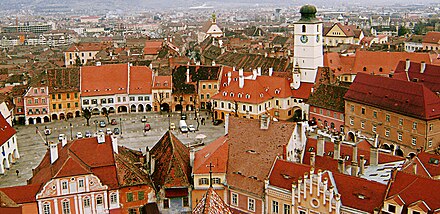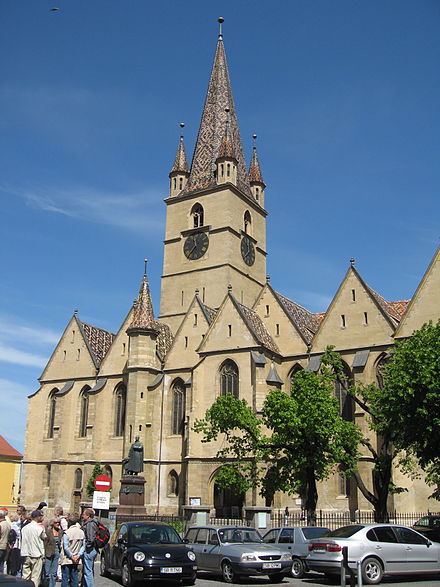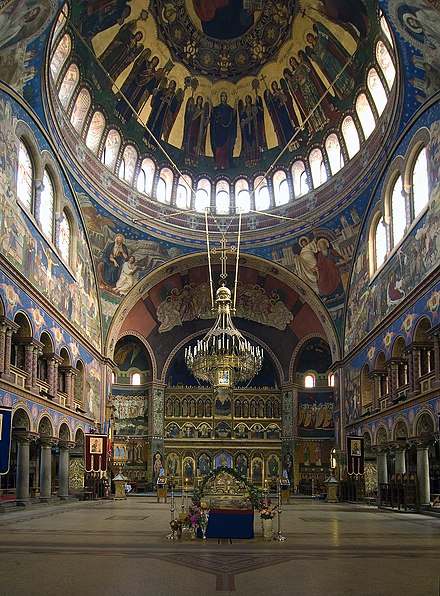Sibiu - city in Sibiu County, Romania
Sibiu is a town in southern Transylvania, Romania, 280 km by road from Bucharest. The old town centre is very attractive. Sibiu is also a good base for exploring elsewhere in Transylvania.
Understand
 Known in German as Hermannstadt and in Hungarian as Nagyszeben, Sibiu has been the centre of Transylvania's German minority since medieval times. Even today, it contains Romania's largest German community, and due to initiatives by the local government, the Germanic feel of the area has been maintained. Sibiu also has a Hungarian minority, remnants of Transylvania's past as part of the Hungarian Empire and, later, Austria-Hungary. Despite this, Sibiu is also distinctly Romanian (95% of the population today are ethnic Romanians) and manages to fuse these three cultures, as well as smaller minorities of Roma, Slovaks and Ukrainians into a city that is as wonderful as it is vibrant.
Known in German as Hermannstadt and in Hungarian as Nagyszeben, Sibiu has been the centre of Transylvania's German minority since medieval times. Even today, it contains Romania's largest German community, and due to initiatives by the local government, the Germanic feel of the area has been maintained. Sibiu also has a Hungarian minority, remnants of Transylvania's past as part of the Hungarian Empire and, later, Austria-Hungary. Despite this, Sibiu is also distinctly Romanian (95% of the population today are ethnic Romanians) and manages to fuse these three cultures, as well as smaller minorities of Roma, Slovaks and Ukrainians into a city that is as wonderful as it is vibrant.
Today, Sibiu is one of Romania's cultural and tourism landmarks, attracting tourists due to its wonderful medieval charm, excellent views of the surrounding landscapes, great food, and stunning parkland. Sibiu today is also doing excellently economically, having an income per capita higher than the Romanian average.
Much of the city was reconstructed in preparation for being the European Capital of Culture in 2007. The people in Sibiu are much more relaxed and friendly than in Bucharest, and much of the city is pedestrian-friendly.
Get in
By plane
- Sibiu International Airport (IATA: SBZ), 45.789023°, 24.094987°. Served by Austrian (to Vienna), Blue Air (to Stuttgart), Lufthansa & Tarom (both to Munich) and Wizz (to Dortmund, London Luton, Memmingen, Madrid, Milan and Nuremberg). There are no direct flights to other cities in Romania, eg for Bucharest you’d face an absurd detour via Munich. Small café & currency exchange, car hire desks. 2017-05-01
By train
There are three trains a day from Bucharest, taking 5 or 6 hours. From Budapest there are two direct trains, departing around 09:00 and 22:30 taking ten hours, plus indirect services taking 16 hours. It's about 5 hours by train from Sighișoara with a change at Mediaș (12.50 lei, Sep 2018). For current timetable the easiest website to navigate is DB. The railway station is 500 metres NE of city centre and next to the bus station.
- Sibiu Central (Gara Mare), 45.800058°, 24.161773°. 2017-05-01
By road
Romanian highways are mostly well-signed and in good repair: reckon 7 hours to drive from Budapest. Drive defensively of course, watching especially for horse-drawn carts; but the lunatic driver quotient is probably lower here than elsewhere in South Europe. Your main difficulty will be finding your way through the old town one-way system to your hotel, ask ahead for precise directions.
Sibiu has buses to Bucharest (roughly 5 hours, run hourly, 50 lei) and Cluj-Napoca (roughly 4 hours, run hourly, 30 lei). There’s also at least one direct bus per day to Budapest (11 hours, 150 lei). The main operators are Dacos, Fany and Transmixt; check times and prices on www.autogari.ro. The buses are reliable, comfortable and cheap. The bus station is next to the train station, listed above. For those who want to rent a car locally by Swiso Rent Sibiu the average starting price for a day's rental (small car) is about €10.
Get around

Walk. The city is large, but almost all the sights of interest are within the compact old centre, much of it pedestrianised. You can hire a guide via the TIC or main hotels, but wandering at random among the cobbled alleys is half the fun.
You need a bike (hire available), car or #13 bus to reach the ASTRA outdoor folk museum, listed below. The fascinating Transylvanian villages (eg Biertan) are within cycling range but the main roads are busy and not much fun by bike, though bike-on-train to Medias is an option. Otherwise either hire a car (see below) or arrange a tour, eg with Tursib. The only other excursion for which you might take the train is to Sighisoara. Reckon 2½ hours, it’s an infrequent service, but the bus connections are worse.
Sibiu taxi drivers are generally decent, and switch on the meter without being nagged. But if you’re silly drunk and wearing a “Please rob me” T-shirt....
Alas, Sibiu’s network of trams and trolley-buses was ripped out in the 2010s, just as other cities were expensively re-installing theirs.
Car rental is available from Rent a Car Sibiu +40 733 910 751 and Primus +40 733 910 753
By bus
Sibiu is one of the few cities in Romania where card payment is accepted for public buses. Just tap your contactless-enabled credit or debit card to the card reader on board, and it will print you a ticket. Visa and MasterCard are accepted.
Route planner for public transport is available online.
See

The Old Town is beautiful. It was mostly built in the late medieval period by the German merchants who were encouraged to settle in and around Sibiu. It’s in excellent condition, having escaped modern encroachments, and having been thoroughly renovated to be European Capital of Culture in 2007. (Standards were maintained in the following decade, in spite of economic woes.) Within Old Town, the Upper Town, containing most of the historic sights, is ranged around three squares: Piate Mare the Great Square, dominated by the RC Cathedral, Piata Mica the Little Square has most of the bars and cafés, and Piata Huet is an attractive Gothic conglomeration around the Lutheran Cathedral. The Lower Town is home to many charming buildings and cobbled squares.
Piata Mare and Piata Mica are linked by a passageway, above which stands the “Council Tower” or Turnul Sfatului.
- The Great Square (Piața Mare), 45.796621°, 24.151758°.
- Huet Square (Piața Huet), 45.797418°, 24.149981°.
- Turnul Sfatului, 45.7975776°, 24.1522729°. Climb the tower and get a panoramic view of Sibiu.
Multiple routes connect the Upper and Lower Towns, the two best being Pasajul Scărilor – the stairway from Piata Huet down into Str Turnului, and alternative cobbled ramp – and down Str Ocnei from Piata Mica under the Iron Bridge. This, being the traditional rendezvous of merchants and of lovers, is better known as “The Bridge of Liars”. About 200 m south of Piata Mare, paralleling Str Cetatii, is the surviving section of the Citadel Walls, with a series of towers and bastions. Beyond this hurries the traffic of the sprawling modern town: the spell is broken.
Churches of interest include:
- the Roman Catholic Cathedral on Piata Mare,
- St Mary's Lutheran Cathedral, on Piata Huet. The church is mostly closed for renovations in 2018 and 2019, but you can still see its excellent collection of medieval tomb covers, including that of Vlad the Impaler's son, Vlad III, who is said to have been murdered by his enemies outside the church after an Easter Sunday service. The tower gives you the highest lookout over the city, and is reached via a series of steep wooden and stone staircases -- this is not for those with mobility or heart problems. Tower 5 lei, church 3 lei 2018-09-15
- St Ursuline’s on Str General Magheru, and *the stunning Orthodox Holy Trinity Cathedral (Catedrala Ortodoxă Sfânta Treime) undefined 📍 on Str Mitropol.
The only museum that ranks as “must-see” is the skansen, the outdoor ASTRA Museum of Traditional Folk Civilization (Muzeul Civilizației Populare Tradiționale) 5 km south of the centre, and listed below. Sibiu’s other museums and galleries are important in a local context, for a nation that is not well endowed – where else could a Romanian go to see a genuine Egyptian mummy, or a Brueghel painting, without leaving the country? But Westerners have huge multicultural riches on their own doorsteps. See the other museums here if time and interest allow, but not through “fear of missing out”.
- Brukenthal National Museum (Muzeul Național Brukenthal), 45.7965°, 24.150611°. Named for Samuel Brukenthal, 18th-century governor of Transylvania. Paintings from the Dutch and Flemish schools, Italian schools and, of course German, Austrian and Romanian collections. Also displays Brukenthal's personal collection dating from the 15th-18th centuries. 2017-05-01
- "Franz Binder" World Ethnography Museum (Muzeul de Etnografie Universala "Franz Binder"), 45.797597°, 24.151052°. Curios that Binder and colleagues collected on their global travels. 2017-05-01
- ASTRA Museum of Transylvanian Civilisation (Muzeul Civilizației Transilvane "ASTRA"), 45.797636°, 24.151145°. Small exhibition space. In April 2017 it displayed 19th-century & modern icons. 2017-05-01
- Steam Locomotives Museum (Muzeul locomotivelor cu abur), 45.7968484°, 24.1665448°. Decaying locomotives near the railway station. 2017-05-01
- ASTRA Museum of Traditional Folk Civilization (Muzeul Civilizației Populare Tradiționale "ASTRA"), 45.754991°, 24.116063°. Daily 09:00-18:00. Huge outdoor collection of traditional farmsteads, waterwheels, mills, labourers’ cottages, churches and so on, picturesquely ranged around a lake in Dumbrava Forest. Pick a fine day, but the circuit track is tarmac so it’s okay when wet. Allow 3 hours to stroll round. 20 lei adult, 10 lei concessions 2018-04-12
Do
- Sibiu Music Festival - second weekend in September. Stages in each of the piatas and near the old city walls.
- After visiting ASTRA, continue driving south through the village of Rasinari, to see that charming rural Romania isn’t just in a museum. From there continue up to the road end at the ski resort of Paltinis. Or turn east for more village scenery via Cisnadioara and Cisnadie, till you loop back to Sibiu via the main north-south highway.
- Ocna Sibiului is a bathing resort some 15 km NE of Sibiu. The lakes are salt, formed by the flooding of ancient salt mines. In some, the waters are utterly black and opaque. Enticing, yes?
- Hike Fagaras Mountains and Cindrel Mountains.
- Guided bike tours around Sibiu.
- Guided enduro trips in the mountains, riding levels from tourist to hard.
- Go on the Transfăgărășan road, crossing the Fagaras mountains with dramatic views. Or Transalpina, 45.7934°, 23.6137°. , an even higher road.
Buy
Lots of souvenir and craft shops, especially on Piata Mica. German language book, incl. history and calenders, at the market square local beer in 2.5 L. bottles. second things from rest of euorpase
Eat
You won’t go hungry. Food & drink here is to a good standard, and cheap by West European standards – reckon €30 for two people with two courses and drinks. The main concentration of restaurants, cafes and pubs is in and around Piata Mica. Hearty Transylvanian fare includes "ciorbă" (sour soup with various meat or veg), “sarmale” (stuffed cabbage leaves), stews and grills, often with mamaliga (polenta). Vegetarians and vegans shouldn’t starve but will need to enquire carefully. Also lots of fast food from familiar chains, but you can do better.
- Crama Sibiu Vechi (The Old Sibiu Restaurant), Str Papiu Ilarian 3, +40 269-210461. noon-midnight. Excellent cellar restaurant offering traditional Romanian cuisine at reasonable prices. 2017-05-01
- La Cuptor, 9 Mai 7, 45.7998236°, 24.1512225°, +40 742 396 696. Daily 13:00-23:00. Good food at reasonable prices. 2018-04-12
- Butoiul de Aur (Golden Barrel), Pasajul Scărilor (foot of stairway down to Str Turnului), +40 746 779 283. Daily 11:00-23:00. Long-established atmospheric place, good food. 2018-04-12
Drink
A local speciality is a "meter" of beer served in pubs.
Liquid The Club on Strada Someșului 19 is a night club which plays mainstream music. The audience is about 50% tourists/locals.
Sleep
Hostels
- Centrum Hostel, Str Gheorghe Lazar 6, +40 747 534 998. 100 m from Piata Mare. Formerly "Flying Time Hostel", no reviews since change. Beds for 35 lei 2018-04-12
- Old Town Hostel, Piata Mica 26, +40 269 216 445. In a 450-year-old building looking onto the Small Square. Breakfast is not included but you can use the kitchen all you want. Laundry is available for €2. Dorms have about 10 beds per room. Rooms from 50 lei 2018-04-12
Hotels
- Zanzi, Str Constitutiei 1, +40 724 528 348. Check-in: 14:00, check-out: 12:00. Small pension near railway station. €22 2018-04-12
- Hotel Apollo Hermannstadt, Str Nicolae Teclu 14, +40 269 212 465. Comfortable and modern hotel. Internet is available in rooms. Rooms start at €56 2018-04-12
- Hotel Continental Forum, Piata Unirii, +40 372 692 692. This modern 13 floor, 182-room hotel is plain but well maintained. Its rooms often have nice views. Often accommodates tour groups. At the edge of the pedestrianised centre of Old Town. Street parking outside is vigorously policed, get permit at reception for checking in, take their advice on medium-stay parking. €60 2018-04-12
- Hotel Imparatul Romanilor, Str Nicolae Balescu 2-4 (just off main square, taxis drop off at end of Str Xenopol 50 metres away), +40 269 216 500. Grand 18th-century pile, very central, atmospheric but in need of sprucing up. 2017-05-01
- Noblesse Boutique Hotel, Str Blanilor 17 (200 m from railway station), +49 369 418 000. Friendly pleasant place just E of old town, close to railway & bus stations. €60 2018-04-12
- Villa Santa Maria, Str Livezii 43 (3 km west of centre, off highway to airport), +40 269 224 451. Cosy 3-star, rooms are well equipped and well kept. Breakfast is included. Free wireless Internet available. English-speaking owners. €40 2018-04-12
- Ana Airport Hotel, Soseaua Alba Iulia 120 (On main hwy 1 km east of terminal, 3 km west of old centre), +4 269 228 875. Simple 3-star near airport. 2018-04-12
Connect
Sibiu and its approach roads have 4G from all Romanian carriers. As of Aug 2022, 5G has not reached this area.
Go next
- Medieval fortified churches but you’ll need your own transport. The Saxon settlements of Transylvania came under attack in the 15th and 16th centuries, but instead of erecting castles, they fortified the churches with walls and lookout towers. Many are clustered around Medias, the best being the UNESCO World Heritage sites of Biertan and Valea Viilor.
- Sighisoara has an attractive old citadel. Other notable old towns include Cluj-Napoca, Targu Mures, and Brașov. Further south, into Wallachia, is Curtea de Argeș an old fortress city in Muntenia.
- Bucharest, but try to visit it before Transylvania. It’s interesting but far from pretty, and it’s going to look especially drab after seeing Sibiu.
Sibiu
sibiu.roSibiu County
Primary administrative division